Adam Yamey's Blog: YAMEY, page 123
June 12, 2022
Not my cup of tea
BEFORE REACHING MADEIRA, many people insisted that we should visit Reid’s Hotel in Funchal and to take afternoon tea there.
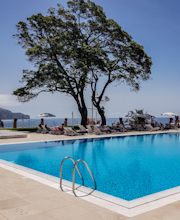 Pool at Reid’s Hotel in Madeira
Pool at Reid’s Hotel in Madeira Located in the western part of Funchal, Reid’s was founded by William Reid, a Scotsman
who arrived in Madeira in 1836. The hotel was his idea but he died before it was
completed (in 1891). The massive seafront establishment was designed by George Somers
Clarke and John Thomas Micklethwaite. It is not great architecture.
Since its opening, the hotel has hosted many famous guests including
Winston Churchill, Albert Schweitzer, George
Bernard Shaw, and Rainer Maria Rilke. Apart from its celebrated guests, the establishment
is famed for its afternoon teas. We decided against partaking of this treat because
it contains far too many sugary confections. We had morning coffee and a pot of
tea by the swimming pools on a terrace overlooking the ocean. By Funchal standards,
it was costly (10 euros) but not outrageously so.
Undoubtedly, Reid’s is luxurious with good service. Its position
overlooking a rocky cove is superb even though it is located in a part of Funchal,
which resembles unexciting slightly upmarket seaside resorts on Italy’s Adriatic
coast. However, the well-appointed hotel seemed somewhat sterile. If sun and sea
is your top priority, then Reid’s is the place to go if you can afford it. However,
it lacks the charm of other places in Funchal.
Well, we did visit Reid’s as people had suggested before we left London but I must say that it is not my ‘cup of tea’.
June 11, 2022
Buried in Madeira
IN CENTRAL SARAJEVO, there used to be a pair of footprints carved on the corner of a pavement where two roads met. I do not know whether these impressions, which I saw in the 1980s, still exist. They marked the spot where a young sharpshooter, Gavrilo Princip, took aim and assassinated Archduke Franz Ferdinand of Austria-Hungary in 1914. Had his aim not been so accurate, the last Emperor of Austria might not have been buried in a church high above the city of Funchal in Madeira.
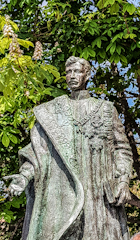 Emperor Karl of Austria-Hungary
Emperor Karl of Austria-Hungary Had Princip’s aim not been so good, his victim, Franz Ferdinand, would have been
successor to the imperial throne. With the Archduke eliminated, his nephew,
Karl (1887-1922), succeeded Emperor Franz Joseph when he died in 1916.
Following the end of WW1 in 1918, Austria’s last Emperor,
Karl, fled to Switzerland. After a couple of attempts to regain his
throne, the British exiled him and his
wife to Madeira in 1921.
In 1922, Karl died of pneumonia. He was interred in a chapel on the north side
of the nave in the Igreja Nossa Senhora in the Monte district high above
Funchal.
Plenty of tourist gawp at Karl’s simple tomb in the lovely church,
which overlooks the city and the Atlantic Ocean far below. I wonder whether Madeira would have been the
final home of the Archduke had he not been so unlucky in Sarajevo.
Curiously, Karl was beatified in 2004. Equally strange was
the British choice of a Portuguese island for Karl’s exile. After all, Napoleon
Bonaparte was eventually exiled to a British possession: St Helena.
June 10, 2022
Diverting water in Madeira
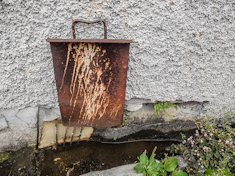 A damming plate hanging on a wall beside a stream in Funchal
A damming plate hanging on a wall beside a stream in FunchalWHEN WE WERE IN the Western Cape of South Africa, I noticed
streams running alongside roads in rural farming areas. Occasional small channels
led off from them and into the fields of farms. At each junction of the main stream
and a side channel, there were small plates that could be used to temporarily dam the main stream to divert water
into the channel leading to the fields.
We are staying in Funchal, Madeira. Our guesthouse is high above
the city centre and the seafront on a road that leads down an extremely steep hill. On one side of the road there is a fast flowing
stream. Every now and then, there are metal plates that can be inserted into
slots on both sides of this stream to divert water into the property beside the
water. This is just like what I saw in rural South Africa. Perhaps I should not
be surprised by the similarity of the damming system, but I cannot recall having
noticed it anywhere else I have visited.
June 9, 2022
Beware of the hound
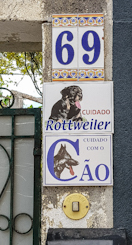 Funchal in Madeira
Funchal in Madeira Better to keep out
This canine might well bite
Cave canem I say
June 8, 2022
Landing in Madeira
MADEIRA IS A PORTUGUESE island in the Atlantic Ocean. Most
people, including us, arrive by air and land at the Airport of the island’s
capital, Funchal.
We flew from London to Lisbon to Funchal on the Portuguese airline. The climax of the somewhat poorly organised and unsympathetic airline‘s handling of its passengers was not entirely the fault of the airline: it was the landing at Funchal airport.
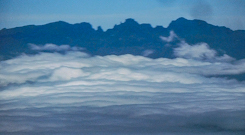
Funchal airport is hazardous to say the least. It consists
of a single short runway with sea along one side and at both ends. This short
runway, rather like that of a large naval aircraft carrier, lies almost
surrounded, not only by water, but also by nearby rocky mountains.
After flying over the empty Atlantic for about 80
minutes, the rocky island of Madeira,
partly shrouded in clouds, loomed into view.
We descended towards the short runway and almost a few seconds before we were to have touched down on the concrete, the pilot caused the ‘plane to ascend steeply. We headed back into the clouds before the pilot announced that his first attempt to land had been thwarted by an unexpected gust of crosswind and that he would make another attempt to land.
I noticed that during the second attempt, we approached the runway far slower than the first time. The few hair-raising minutes before we touched down seemed like hours, so anxious I was beginning to feel. It was a great relief to set foot on the tarmac when we left the aircraft.
The cabin crew laughed at us when we told them how scared we
were during the landing. They could have tried to be reassuring at the very
least. I was unimpressed by their reaction to our concern.
Terrifying and alarming as was the landing, Funchal is proving to be a delightful destination.
June 7, 2022
Grim warnings along the road
IN THE EIGHTEENTH century, travelling by road in England was not without its dangers, One of these was being robbed by highwaymen. Frequently, individual travellers and passengers in horse-drawn coaches were stopped by bandits, who were after money, jewellery, and other valuables.
[image error]Pexels.com" data-medium-file="https://yamey.files.wordpress.com/202..." data-large-file="https://yamey.files.wordpress.com/202..." src="https://yamey.files.wordpress.com/202..." alt="" class="wp-image-8547" width="510" height="339" srcset="https://yamey.files.wordpress.com/202... 510w, https://yamey.files.wordpress.com/202... 1017w, https://yamey.files.wordpress.com/202... 150w, https://yamey.files.wordpress.com/202... 300w, https://yamey.files.wordpress.com/202... 768w" sizes="(max-width: 510px) 100vw, 510px" />Photo by Rene Asmussen on Pexels.comEven close to London, for example between Mayfair and Hammersmith, highwaymen plied their evil trade. As an example, the diarist Samuel Pepys (1633-1703) recorded in his entry for the 19th of May 1669:
“Here news was first talked of Harry Killigrew’s being wounded in nine places last night by footmen in the highway, going from the park in a hackney coach toward Hammersmith to his house at Turnam greene [sic] …”
The punishment for highwaymen, who were captured, was often death by hanging. Many of those convicted of crimes in the countryside around London were hung at Tyburn, close to where London’s Marble Arch stands today. Ending a highwayman’s life at Tyburn was often not the end of the story as is shown in this extract from Select Trials, for Murders, Robberies, Rapes, Sodomy, Coining, Frauds, and Other Offences. At the Sessions-House in the Old-Bailey. …, (published in 1742):
“The same day that Hawkins and Simpson were hanged, their bodies were carried to Hounslow Heath, and there hanged in irons on a gibbet erected for that purpose, not far from that on which Benjamin Child was hanged in the same manner…”
Hounslow Heath was a vast area in Middlesex, now covered mostly by west London and Heathrow Airport. It was crossed by several important roads from London to the west and south west. In between the small villages that were dotted about the Heath, there was no shortage of highwaymen and the potential for stealing much of value was great on these major arteries. The quote above mentioned that the bodies of the two fellows who were hung at Tyburn were taken to Hounslow Heath to be hung in irons. Back in those times, the bodies of executed highwaymen were hung from gibbets alongside the main roads in order to deter others from being tempted to rob travellers. How effective these grim warnings were in preventing highway robberies, I do not know.
June 6, 2022
A pioneering bridge
THE CONCRETE PEDESTRIAN bridge over the railway tracks at Kew Gardens Station cannot be described as attractive. In fact, it is rather ugly. However, on a recent visit to the station, I spotted a notice attached to the bridge that provides interesting information about it.
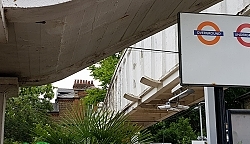
The bridge was opened in 1912. It is one of the earliest examples of the use of reinforced concrete in Britain. The technique used to construct this bridge was that pioneered by François Hennebique (1842-1921). The first building made in Britain using his method of reinforcing concrete with wrought iron beams was the Weaver Building in Swansea (in 1897). An article in Wikipedia related that between 1892 and 1902, over 2000 structures were made using Hennebique’s method. This makes me wonder why the plaque on the bridge at Kew is described as a “rare example” of this kind of structure. Maybe, what is meant is that it is a rare surviving example of his construction method. In any case, the bridge at Kew incorporates two features that were designed to protect users of the bridge from the smoke produced by steam engines that used to travel beneath it. One feature is the high wall on each side of the pathway over the bridge. The other are small projections over the railway lines, which were designed to deflect smoke from the bridge.
Kew Gardens station was opened in 1869. It is the only station on the London Underground network to have a pub attached to it. In the past, this pub, now known as The Tap on the Line, had an entrance directly from the London bound platform. In addition to the bridge described above, there is also an underground pedestrian passageway running beneath the tracks. The main reasons to use this station are to visit the National Archives and/or Kew Gardens. If you are coming from central London to visit the gardens, you will have to cross the tracks. So, why not cross them on a bridge that, although ugly, is a landmark of engineering history?
June 5, 2022
A dachshund on board
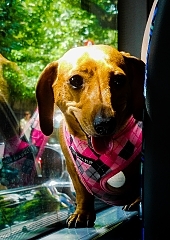 Dachshund on a London bus in Bayswater Road
Dachshund on a London bus in Bayswater RoadYou cannot tell
With whom you will be travelling
On a London bus
June 4, 2022
Images of my mother’s sculptures rediscovered
MY LATE MOTHER (Helen Yamey: 1920-1980) trained as a commercial artist in Cape Town (South Africa) before WW2. In 1948, she came to London to marry my father. In London, she painted and, according to my father, took lessons from the great Stanley Spencer (1891-1959). Around the time when I was born (1952), my mother began making sculptures. The first of these was a terracotta mother and child. Maybe, she was depicting herself with me in her arms. By the 1960s, she was working in the sculpture studios of St Martins School of Art, which was then near Foyles bookshop on Charing Cross Road. There, she was in the company of artists such as Anthony Caro, William Tucker, Philip King, and William Turnbull. At least one of these now famous artists taught my mother how to weld and solder.
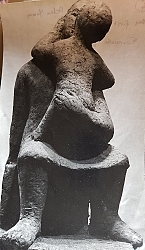
My mother exhibited her works in important art galleries at least twice. In late 1961, she exhibited at the Institute of Contemporary Art in a show called “26 young Sculptors”. In 1962, she exhibited sculptures at the Grabowski Gallery, along side works by Maurice Agis and David Annesley. Although she sold a few of her creations, she did them more for pleasure than for profit.
My mother was a perfectionist. She destroyed much of what she created. However, at some time during the 1960s, she had a series of professional photographs taken of some of her mainly abstract works. These were kept in a yellow Kodak photographic paper box in a drawer in our home in Hampstead Garden Suburb. As a teenager, I used to look at them occasionally and wonder what became of some of the creations recorded in these photos.
My mother died in 1980 and my father remarried 11 years later. After remarrying, he and my stepmother moved from our home in Hampstead Garden Suburb to another house (near Primrose Hill). After the move, I used to ask him what had happened to the photographs of my mother’s sculptures and other family photos. Each time I asked, he would say that they were stored somewhere, possibly in the garage of his new home. After a while, I gave up hope of ever seeing these pictures again because it was clear to me that Dad had little or no interest in these photographs and in addition he could not imagine why anyone else would find them interesting. My father died, aged 101 and 6 months, in 2020. What with covid19 and its associated problems, we did not see his widow, my stepmother, again until recently this year (2022).
When, at last, we met her, she arrived carrying a plastic carrier bag, which she handed to me. To my great delight, it contained the box of photographs described above and another filled with family photographs taken mainly in the late 1950s. My stepmother told me that she had found them when she was sorting things in the garage of the house where she and my father had lived.
The photographs of my mother’s sculptures all bear the name of the photographer: Joseph McKenzie, ARPS (95 Blenheim Gardens, Wallington, Surrey). According to Wikipedia, Joseph McKenzie (1929-2015) is regarded as “father of modern Scottish photography”. More relevantly in the context of my mother’s works, he taught photography at the St martins School of Art.
Some of the photographs have notes written on their backs. The handwriting is my mother’s. One of the pictures, that of the mother and child has the words: “my first ever sculpture, terracotta, mother and child, 24””. Some of the other photos have information about the size and the material of the work depicted.
About 10 years before she died, my mother became disillusioned and practically gave up making sculptures. Although she made a few abstract images in pen and ink and a few carvings in alabaster, her abandonment of sculpture making as a full-time activity left a great hole in her life.
I have taken pictures of the photographs, and they can be seen on:
June 3, 2022
Crossing the Equator in a Roman toga
MY PARENTS WERE born in South Africa. They settled in England in about 1947/48. In 1955, when I was three years old, my parents took me on a visit to their native land, possibly to show me off to relatives who lived there.
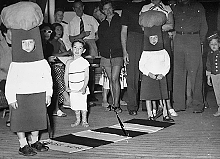
We travelled to Cape Town by sea. I remember nothing of the voyage, which must have taken about two weeks. Recently, I came across a photograph, which had remained in storage for several decades in my late father’s garage. The picture shows a little boy in a white outfit resembling a Roman toga. He is standing between two children dressed up to resemble, if your imagination is good enough, Belisha beacons such as are found at pedestrian crossings of the zebra variety.
The photograph reminded me of what my mother had told me many years ago. During our voyage to South Africa, we crossed the Equator. My mother told me that to celebrate this event, there was a fancy-dress party for the children on-board. My mother, unlike some of the other parents, had not been aware that this was going to take place. So, she had not packed a costume for me to wear. Ever resourceful and extremely creative (she was a painter and sculptor), Mom used one of the sheets from a bed in our cabin to wrap me up as if I was wearing a toga. Looking at the photograph, it appears that also she fashioned a pair of what look like Roman sandals, using some string. Thus, during my first crossing of the Equator, I was attired in a Roman toga.
Looking at this image, which includes a rug designed to look like a pedestrian crossing, made me think. There I was standing halfway across a zebra crossing whilst our liner crossed from one side of the Equator to the other.



